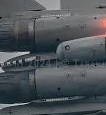Only if you could read what I sent next
Wow, seriously?
Does it way better than su47, only if you searched it up on YouTube for its airshow performance
As if you didn’t just reply to 1 point for the maneobrability above.
If you could read, you would’ve seen that even without the coating su57 is by far stealthier than su47, but I’ll repeat it again :-
- canted tails :- su57 - yes , su47 - no
- faceted nose :- su57 - yes, su47 - no
- radar faced upwards, su57 - yes, su47 - no(doesn’t even have it but the ones which were planned aren’t AESA that they are faced upwards)
- backward swept wings :- su57 - yes , su47 -no
- serrated edges :- su57 - yes, su47 no
- canopy designed for stealth :- su57 - yes, su47 - no
- decent internal bay storage :- su57 - yes, su47 - barely (only has 2 internal hardpoints and will need to use external hardpoints for a reasonable weapon load)
- serpentine intakes :- su57 - no, su47 - yes (this one is arguable because su57 prefers radar blockers and variable intakes for multiple reflections through ram coated intakes to reduce signals drastically, like s shaped intakes)
TLDR, su57 even without coating has far better stealth, maneouvrability too





